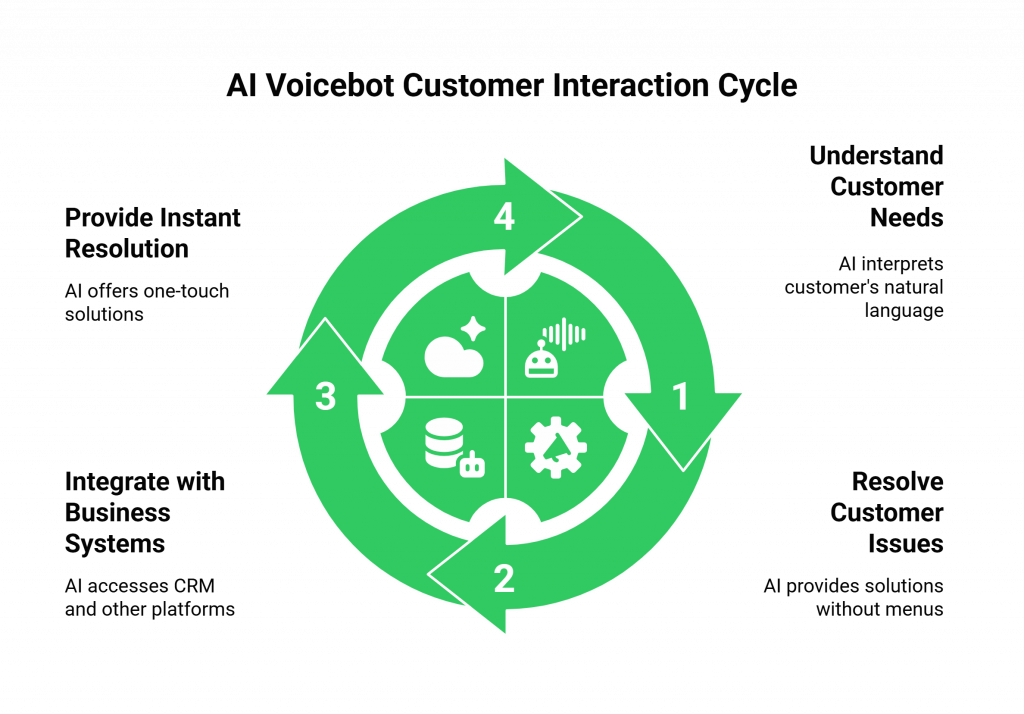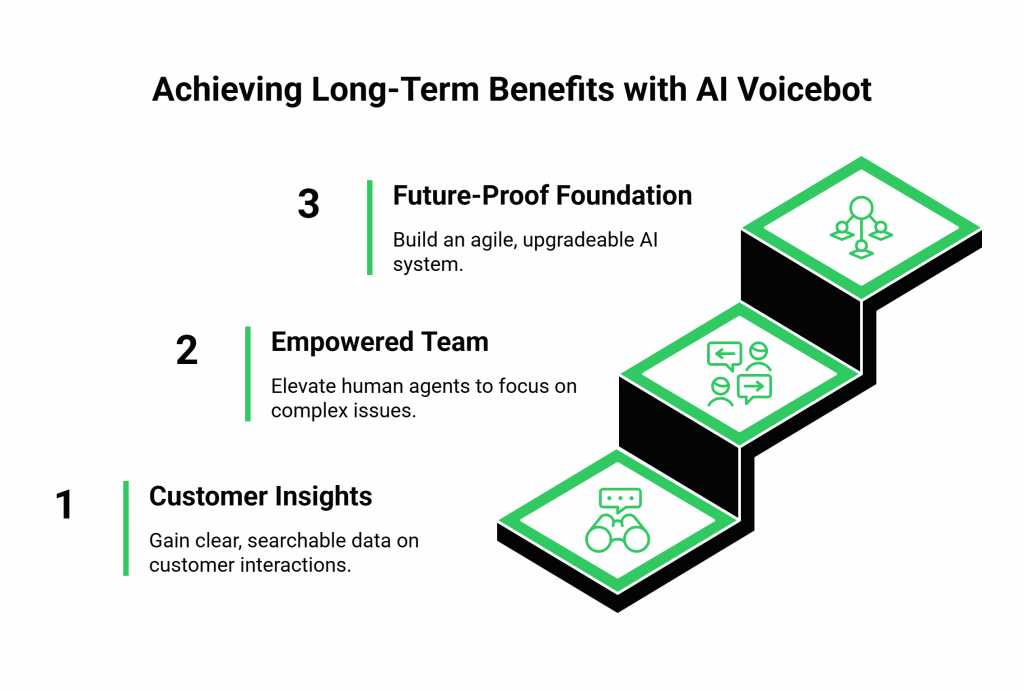For a generation, the sound of a business’s front line has been the impersonal, robotic voice of the Interactive Voice Response (IVR) system. “Press one for Sales. Press two for Support.” It was a technology born of a noble goal: to bring order to the chaos of inbound call handling solutions.
It was a digital traffic cop, designed to direct the flow of calls. But over time, this once-innovative solution has become a symbol of customer frustration, a rigid, multi-layered maze that customers are forced to navigate.
The IVR is a relic of a bygone era, a clumsy tool in a world that demands speed, intelligence, and personalization. Today, a new, far more powerful technology is not just upgrading the IVR; it is making it obsolete. The AI voicebot has arrived, and it represents a fundamental paradigm shift in how businesses interact with their customers.
This is not a simple software update; it is the “big upgrade.” It’s about moving from a system that directs traffic to one that resolves it.
This guide will explore why this migration is a strategic imperative, break down the architectural differences, and provide a clear roadmap for replacing your frustrating phone menu with a truly intelligent conversational partner.
Table of contents
Why is the Traditional IVR Failing the Modern Customer?
To understand the power of the upgrade, we must first be honest about the failures of the old system. The traditional IVR is failing your business and your customers in three critical ways.
How Does It Create a “Cognitive Load” Nightmare?
The human brain is not a computer. It is not designed to listen to, remember, and process long, spoken lists of options. This is a psychological concept known as “cognitive load.” A famous paper by psychologist George A.
Miller suggested that the number of items an average person can hold in their short-term memory is 7 ± 2. A traditional IVR menu that presents eight, nine, or ten options is actively working against human psychology. It forces the user to do all the work, creating a stressful and error-prone experience.
Why is it a “Black Hole” for Customer Intent?
An IVR system provides you with very limited, low-quality data. You might know that 60% of your callers pressed “2” for support, but you have absolutely no idea why they were calling. What were their specific problems? Were they frustrated or happy? Were they all calling about the same product issue?
The IVR is a black hole that swallows up the most valuable data your business can get: the raw, unfiltered voice of the customer.
How Does It Project a “We Don’t Have Time for You” Message?
More than anything, a long and complex IVR sends a subtle but powerful message to your customers: “We are very busy, and you need to do the work of sorting yourself into the right box before we will deign to speak with you.” It creates an adversarial, impersonal first impression. In an era where customer experience is the primary competitive differentiator, this is a self-inflicted wound.
A recent Salesforce report found that a staggering 80% of customers now say the experience a company provides is as important as its products, and the IVR is often the very first experience they have.
Also Read: The Rise of Multimodal AI Agents Explained
What Makes an AI Voicebot a Fundamentally Different Solution?
An AI voicebot is not just a “better IVR.” It is a completely different species of technology, built on a foundation of natural language and artificial intelligence.

How Does It Eliminate Menus with Natural Language?
This is the core architectural difference. An AI voicebot doesn’t have a menu. It has a conversation. It uses Natural Language Understanding (NLU) to understand what a customer is saying in their own words.
- IVR: “Press 4 for order status.”
- AI Voicebot: “How can I help you today?”
- User: “Hi, I’m just calling to check on where my package is.”
The AI understands that this is an “order status” inquiry without forcing the user to learn a new system. It meets the customer where they are.
- User: “Hi, I’m just calling to check on where my package is.”
How Does It Move from “Routing” to “Resolving”?
An IVR’s only job is to route a call. An AI voicebot’s primary job is to resolve the call. By integrating with your business systems (your CRM, your e-commerce platform, your knowledge base), a voicebot can become a fully functional, automated agent. It can:
- Look up an order and provide the tracking number.
- Answer a specific question about your return policy.
- Book or reschedule an appointment.
- Process a payment.
This ability to provide an instant, one-touch resolution is the key to creating a truly efficient and satisfying experience.
Also Read: How Teler and OpenAI’s AgentKit Are Powering the Next Generation of Voice AI Agents
What is the Step-by-Step Roadmap for “The Big Upgrade”?
Migrating from a legacy IVR to a modern AI voicebot is a strategic project that can be broken down into a clear, manageable process.
- How Do You Analyze Your “Call Drivers”? The first step is to use your existing call center data to identify the top 3-5 reasons that customers are calling you. These are your “call drivers.” Don’t try to automate everything at once. Focus on the highest-volume, most repetitive inquiries first. This is where you will get the biggest return on your investment.
- How Do You Design the Conversational Experience? This is a creative, not just a technical, process. You need to design a conversation, not a menu. Write a script for your chosen call driver. What is the most natural and empathetic way to greet the caller? What specific pieces of information does the AI need to collect to resolve their issue? What is the ideal personality for your brand’s voice?
- How Do You Build on a Modern Voice Infrastructure? You cannot build a next-generation AI on a last-generation phone system. The big upgrade requires you to move from your old, on-premises PBX hardware to a modern, cloud-based voice infrastructure. A platform like FreJun AI is the essential foundation for this. Our philosophy is simple: “We handle the complex voice infrastructure so you can focus on building your AI.” We provide the high-performance, ultra-low-latency, and infinitely scalable voice layer. Our powerful, API-driven platform gives you the granular control you need to build these advanced, intelligent workflows.
- How Do You Integrate Your Business Systems? The real intelligence of your voicebot comes from its ability to connect to your other business systems. This is where you’ll use APIs to integrate your voice assistant with your company calendar, your CRM, and your knowledge base. This is what allows it to move from a simple router to a true “resolver.”
- How Do You Implement a “Phased Rollout”? Don’t switch your entire phone number over to the new system on day one. A phased rollout is the best practice. Start by routing just a small percentage (e.g., 10%) of your call traffic to the new AI system. Monitor its performance, gather data, and use those insights to continuously improve the script and the logic before you gradually increase the traffic.
Ready to replace your frustrating phone menu with an intelligent conversation? Sign up for FreJun AI!
What Are the Long-Term Benefits of This Upgrade?
The move from a rigid IVR to an intelligent AI voicebot is one of the highest-ROI projects a business can undertake.

- A Goldmine of Customer Insights: Every call is transcribed and analyzed. You finally have a clear, searchable, and data-rich view of exactly why your customers are calling, what their pain points are, and how they feel.
- An Empowered Human Team: By automating the repetitive front-line, you elevate the role of your human agents. They are freed up to become true experts, focusing on the most complex and high-value customer interactions.
- A Future-Proof Foundation: An API-driven, cloud-based architecture is agile. By building on a model-agnostic platform, you ensure that you can always upgrade your AI “brain” to the latest and most powerful technology without having to rebuild your entire system.
Also Read: How Developers Can Use Teler and AgentKit to Build Human-Like Voice Agents
Conclusion
The traditional IVR had its day, but that day is over. It is a relic of a past when the technology was not yet capable of having a true conversation. Today, the technology has arrived. The “big upgrade” to an AI voicebot is a strategic imperative for any business that is serious about providing a modern, efficient, and customer-centric experience.
By embracing this transformation, you can do more than just improve your inbound call handling solutions; you can fundamentally change your relationship with your customers, moving from a world of frustrating menus to one of intelligent, helpful, and effortless conversations.
Want to see a live demo of an AI voicebot replacing a traditional IVR? Schedule a demo for FreJun Teler to see the difference.
Also Read: Outbound Call Center Software: Essential Features, Benefits, and Top Providers
Frequently Asked Questions (FAQs)
A legacy IVR uses a rigid, touch-tone (DTMF) based menu that forces users down a predefined path (“Press 1…”). An AI voicebot uses Natural Language Processing (NLP) to understand a user’s spoken words in their own language, allowing for a much more natural and flexible conversation.
No. A “phased rollout” is the recommended approach. You can start by routing just one specific type of call (like “order status”) from your existing IVR to your new AI system. This allows you to test and prove the value of the new technology with minimal disruption.
The cost has come down dramatically. Modern cloud-based voice systems are much more cost-effective than managing on-premises hardware. The AI models themselves are priced on a pay-as-you-go basis. The return on investment is often very high due to cost savings and improved customer retention.
“Call drivers” are the primary reasons that customers are calling your business. Analyzing your call data to identify your top 3-5 call drivers is the critical first step in planning your automation strategy.
A well-designed AI voicebot will always have a seamless “escape hatch.” When it recognizes a problem is beyond its capabilities, it will perform a “contextual handoff,” transferring the call and all the conversation history to the appropriate human agent.
A contextual handoff is the process of seamlessly transferring a call from an AI agent to a human agent along with the full history of the AI’s conversation. This allows the human agent to start their interaction fully informed, without asking the customer to repeat themselves.
Yes. By integrating with AI models that support multiple languages, you can easily create an intelligent alternative to a complex, multi-language IVR menu.
A model-agnostic voice platform like FreJun AI is not tied to a specific AI “brain.” This is important because it gives you the freedom to choose the most powerful and cost-effective LLM for your specific business needs and to easily upgrade it in the future.
Success is measured with clear KPIs, such as a decrease in call abandonment rates, an increase in First Call Resolution (FCR), an improvement in Customer Satisfaction (CSAT) scores, and a high “containment rate” (the percentage of calls fully resolved by the AI).
FreJun AI provides the essential, modern voice infrastructure that is the foundation for the “big upgrade.” We provide the cloud-based telephony, the ultra-low-latency real-time streaming, and the powerful APIs that are the necessary building blocks for any intelligent inbound call handling solutions.
